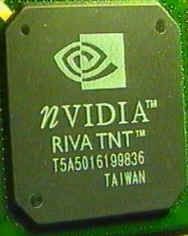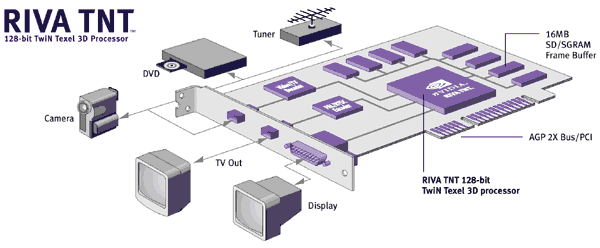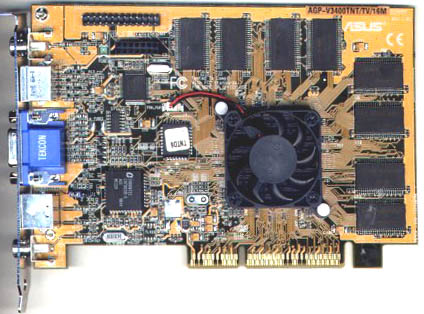Riva TNT
1998 The third generation of 3D accelerators. Prerequisites: support for multitexturing, trilinear filtering, high fill rate, high resolution support.

Nvidia specialists understood perfectly well that only a truly high-quality product could win in the market of third-generation 3D accelerators. And to win, you will need to compete well for the title of the best. And there was someone to fight. In terms of speed, the market is dominated by a configuration of two Voodoo2s in SLI mode. In terms of quality in Direct3D - Matrox G200. Other products like Permedia 2, Verite 2x00 have good OpenGL support. In addition, 3dfx, ATI Technologies Inc. and 3Dlabs announce their products claiming to be third generation accelerators. This is exactly the situation in the world of 3D accelerators. But nVidia found the right solution. RivaTNT - that was her answer. TwinTexel technology, which provides the presence of two texture modules in one chip, 128-bit memory access, 128-bit rendering pipeline,
| Name | Riva TNT |
| Core | NV4 |
| Process technology (µm) | 0.35 |
| Transistors (million) | 7 |
| Core frequency | 90 |
| Memory frequency (DDR) | 110 |
| Bus and memory type | SDR-128bit |
| Bandwidth (Gb/s) | 1.76 |
| Pixel pipelines | 2 |
| TMU per conveyor | 1 |
| textures per clock | 2 |
| textures per pass | ? |
| Vertex conveyors | No |
| Pixel Shaders | No |
| Vertex Shaders | No |
| Fill Rate (Mpix/s) | 180 |
| Fill Rate (Mtex/s) | 180 |
| DirectX | 6.0 |
| Anti-Aliasing (Max) | No (?) |
| Anisotropic Filtering (Max) | No (?) |
| Memory | 16MB |
| Interface | AGP2x/PCI |
| RAMDAC | 250MHz |
Riva TNT is a completely new chip, not a modification of the old one (like Riva 128ZX).
The new Twin-Texel technology made it possible to apply two textures to one pixel per clock in multitexturing mode. Thus, it was possible to impose a texture and light map on a pixel without losing speed. If the application did not use multitexturing, Riva TNT applied one texture two pixels per clock. This means that in multitexturing mode, the fillrate should be almost half that in normal mode. However, in practice, when applying multitexturing in applications, the speed increases by an average of 10 to 40 percent. So the ability to apply two textures per clock is a tasty morsel implemented in TNT.
8-bit pattern buffer. With this function, it was possible to get quite real shadows. It really came in handy in Unreal and Quake III Arena games. In the last game, due to the 8-bit template buffer, the most realistic shadows I've seen in games were obtained.
Z-Buffer 16 and 24 bits. Compared to the Riva 128ZX, where the Z-Buffer was only 16-bit, the picture quality improved significantly.
Support up to 16 MB of memory. Allowed to set resolutions up to 1920x1200.
32-bit rendering improved the quality of the output image
Polygon mipmapping improved image quality in some cases
Support for procedural textures. A fairly new possibility. Procedural textures can be seen in Unreal, Quake 3 Arena. They were used to create water, energy fields, and so on. Pretty useful stuff.
Strip support. Polygons can be arranged randomly, or they can be sorted into stripes. In this case, for each polygon, data is transmitted only for one vertex instead of three. Due to this, the performance of processing 25-pixel polygons increases almost three (!) times. Riva TNT supported three types of filtering: Bilinear, Trilinear and Anisotropic. Here you need to stop in more detail.
Bilinear filtering is supported by all 3D chips today, as it was in 1998. But Riva TNT had problems with trilinear filtering. At that time it was very important to include hardware support for trilinear filtering in new 3D chips. That is why some manufacturers deceived buyers with the help of the so-called "approximation", which in translation meant approximation. Its essence was that only the transition areas between MIP levels are filtered. This method was very efficient in terms of speed, but in no way suited for quality. The image quality when using trilinear approximation fell and looked worse than when using bilinear filtering. But the approximation was not as resource-intensive as an honest trilinear, so when it was turned on, the speed practically did not drop. So. Approximation was implemented in Riva TNT. For what? So that you can safely talk about the support of the trilinear in games, presenting the results and keeping silent about the fact that this is an approximation. Fair trilinear filtering can be obtained by turning off multitexturing.

As for DiME support. Riva TNT could not work properly with textures stored in system memory. Until the end of 1999, it was impossible for most users to check this, since there were no games that supported a large amount of textures. At the end of 1999, Quake 3 Arena was released. Here, each level accounted for 27 megabytes of textures and more. When maximum texture detail was enabled, they did not fit into the local memory of the video card and were loaded from the system memory. This is where Riva TNT showed its inability to work with large textures.
As for the 2D part. Riva TNT inherited 250 MHz RAMDAC from Riva 128ZX. Therefore, the quality in 2D should not have increased. In addition, at resolutions above 1024x768 there was "blurring" - that is, a fuzzy image. For those who used Riva TNT for games it was not essential, but for office applications it was unacceptable.
Riva TNT does not have an inverse Fourier transform function. This function is used to decode DVD video files. At the same time, the central processor is unloaded and the quality increases. But nVidia considered this feature unnecessary for their product.
As for TV in/out, Riva TNT had NTSC and PAL TV output, CCIR-656 video capture port, supported all the same functions as Riva 128 ZX.
Therefore, buying Riva TNT for 2D applications and video was unprofitable.
Here, unlike the Riva 128, there was nothing to complain about. Riva TNT came with excellent drivers, depending on the manufacturer, with different settings. Nvidia released reference drivers for their product with such frequency that native drivers from video card manufacturers soon became outdated and quickly outdated. Almost all video cards based on Riva TNT could work with reference drivers. The performance of video cards has been increased in the Detonator drivers. And since version 2.08, rendering quality has been noticeably improved. But what is really interesting is the fact that in one of the versions of the drivers, nVidia disabled multitexturing in 16-bit color, so that work in this mode is slower. Then, on this background, the transition to 32-bit color, where multitexturing is enabled, was accompanied by a slight drop in speed, which was used by nVidia in an advertising campaign. Fortunately for users, multitexturing could be enabled with a little digging in the system registry. In subsequent drivers, nVidia fixed everything in place.

As far as Direct3D is concerned, Riva TNT supported this standard at the highest level. No errors or crashes. After the development of Riva TNT, nVidia entered the so-called OpenGL club. I won’t say the name exactly, but those developers who create OpenGL hard and soft are accepted there. Is it worth it after that to talk about high-quality support for OpenGL? Riva TNT could be used not only for games, but also for running OpenGL applications such as 3D Studio MAX.iva TNT has undoubtedly become the leader of the 3rd generation 3D accelerator race. But one feature did not allow many users who bought Riva TNT to sleep peacefully. The point is that the initially announced characteristics of Riva TNT were higher than those of the cards that were on sale. For example, initially Fillrate was promised 250 MTexels/sec. And the maximum processing speed is 8 MPolys/sec.



